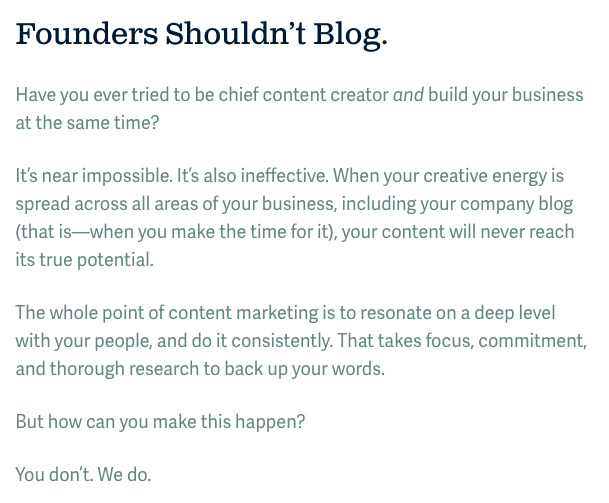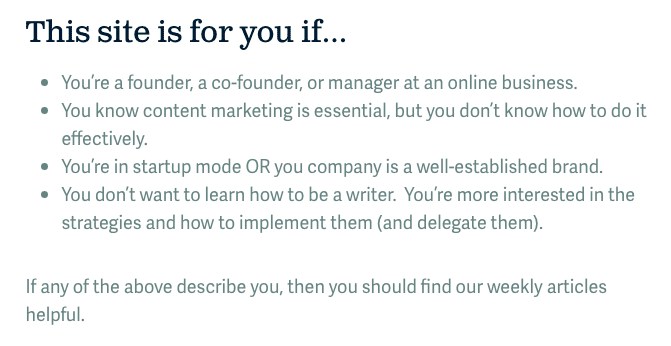Remember the idea behind Groupon?
The company would approach local merchants – restaurants, yoga studios, flower shops and the like – and convince them to offer Groupon subscribers in their area a service for a discount. Delighted members could get a 2-for-1 entree or a buy-one-get-one-free class, saving a ton on regular rates. Who can resist BOGO brunch?!
Groupon convinced merchants that these “loss leader” high-percentage off deals would bring in droves of new customers, leading to a brand-new customer base. Groupon would handle all the details and bring the audience for the coupon – all the merchant had to do was pay some service fees to Groupon and honor the coupon.
The only problem? The “loss leaders” became permanent losses.
The people who came in brandishing 50 percent off coupons turned out to be people hunting for deals – not people looking to become repeat customers of new establishments. Merchants saw very little return for their investment.
Today, Groupon’s stock languishes in the bargain basement and competitor LivingSocial fares little better. The slow fade of their business model can be partially attributed to merchants getting wise to their pitch.
They’ve learned – it stinks to shell out money to attract the wrong kind of customer.
So what does this story have to do with content marketing? A lot!
Like many content marketers, we believe firmly in the value of targeted buyer personas and knowing your ideal audience so you can tailor your content to provide solutions to their problems.
What we also know is that there’s a dark side to those sunny, aspirational “Founder Fred” and “Marketer Mary” personas – the customer you don’t want.
That’s why negative personas are almost as important as your buyer persona. They help you figure out how to repel the customers who will waste an enormous amount of your resources and time (which for a startup founder is a resource).
“But, Claire,” you might be thinking, “We’re not at the point right now where we can turn a ton of customers away or risk alienating people who might pay for the product.”
And it’s true that casting a wide net might snag you more paying users than if you’re only fishing in one spot. Your initial numbers might be awesome. But you’ll end up “spending” more resources on the poor-fit prospects and customers than they’ll be worth.
As Ann Handley of MarketingProfs writes at GetResponse, “It’s a waste of time and resources to nurture relationships with people who are a bad fit for your business. It makes your nurturing programs seem far less robust than they actually are.”
How to Use Negative Personas and Failed User Journeys
Negative personas are also called exclusionary personas. Marketing teams create them to learn who to avoid talking to when creating messaging, content and various other plays.
Creating these can help you fine-tune your marketing strategy.
1. Help your team understand what bad fit looks like and why.
A lot of times, your team will be the ones who encounter these people first. They’re on the front lines and may have been dealing with failing customers for a long time before you’re made aware of an issue.
Educating and empowering your team to flag these types of prospects and customers themselves can lead to much better early detection.
Part of creating a good persona is to help your team understand what a bad fit looks like – as opposed to, say, a difficult customer who’s still a good fit.
HubSpot discusses creating exclusionary personas and recommends marketers include real quotes from real people to help your team recognize these customer archetypes in the future.

Providing specifics for your team can help everyone chip in to raise red flags on bad-fit prospects and customers. Credit: HubSpot
2. Understand where your product fails this user.
It’s important to remember that although they may be causing you a lot of grief, bad-fit customers are not bad people.
After all, it’s your product that’s failing them. And it was your marketing that didn’t lay out your value proposition thoroughly enough or articulate who this product is for.
It’s your responsibility to recognize where you’re going wrong and make a plan to move this customer off of your product, while helping them understand why your product isn’t a good fit.
Creating a document that outlines the typical journey of a user who can’t achieve success with your product helps you set up better filters and scoring models that will help you identify these poor fits earlier.
It can also help you arm your customer success team with the right language to defuse an upset user. If you can show you understand where the product has failed them and you understand their concerns, you might be able to keep that person as a fan of your company even while you’re helping them to stop using your product.
3. Use the process of creating a negative persona to sharpen your ideal persona.
Growing a business is a learning process. Especially in the early stage, your ideal persona is pretty aspirational, and you might not know if you really have good product-market fit until you have some real customers to test with.
You can get a silver lining out of the process of working on negative personas, or simply the learning process of going through your first bad breakup with a bad fit customer. Use that experience to make your ideal personas better.
Realized that businesses in a certain stage are a terrible fit for your product, even though the business fit your profile? Add to your profile and specify the stages you now know are the right fit, for example.
4. Speak more directly to your ideal persona.
Once you’re solid on who you really want to be using your product, address everything to that person. For instance, we know that Audience Ops could be a great tool for marketing managers – and we work with a ton of awesome marketing managers. They’re a successful customer for us.
But, we’re really targeted at founders. We’ve found our product works best for a founder whose company has outgrown his or her ability to create content themselves.
We position all our messaging toward founders, including our home page:

…and on our blog landing page:

5. Actively talk about who you aren’t for.
We do this at Audience Ops too. While we love helping our clients with done-for-you content marketing, we’re not the right fit for everyone. We know this through experience and also because we’ve actively refined our product to be the right fit for a specific customer.
So we describe our ideal customer in most of our website landing pages, including this language from our “New Here?” blog landing page:

This isn’t exclusionary language – it’s setting expectations for which visitors will find our blog content helpful. That lessens the chance that anyone navigates away thinking, “What a waste of time that was for me,” if they’re not the right fit anyway. Think of it as a little self-qualifying exercise for your prospects that saves you having to do that later on in the process.
If Your Funnel is Too Wide, It’s Worth Taking Time to Fix
The most important thing to understand about the customers who are a bad fit is that you must let them go.
Do not fall into the trap of altering your processes for these people. If you’re spending 80 percent of your time greasing the squeaky wheel who is the wrong type of customer altogether, it will have long-term adverse effects on your team.
As Ann Handley writes for GetResponse, “It’s also emotionally exhausting” to spend time and resources on people who are a bad fit. Your team will get burned out trying to help this person to success that can’t be achieved with your product.
Working on negative personas and understanding where and why your users fail can be the first step in tightening up your marketing and sales processes.
Enjoyed this article? We create these types of articles for our clients and work to promote them with our done-for-you service. Want to know more? We’ll call you.